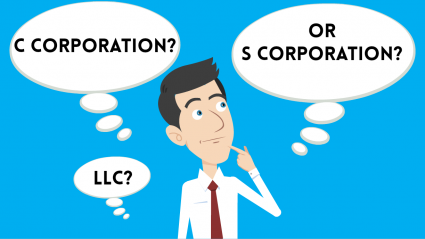Major changes are afoot in the new tax plan for C Corporations, but it’s important to think ahead before making any hasty decisions.
January 12, 2018
By: Diane Kennedy, CPA USTaxAid.com

C Corps have to use the accrual basis unless they qualify for cash basis. It’s almost always better to use the cash basis. Under the old law, the average of the past 3 years of gross receipts need to be less than $5 million in order to use cash basis. The new law says your gross receipts need to be less than $25 mill. That gives you a lot more leeway.
Can all taxpayers with inventory use the cash basis? Yes, but it’s complicated under the current law. It just got a whole lot easier if your average gross receipts are under $25 mill.
One of the things we accountants hate is Section 263A, aka the uniform capitalization law. That means you have to capitalize a portion of your G & A costs, based on how much inventory you have. Under the new law, you’re exempt if your average receipts are under $25 mill.
The Section 179 immediate expensing limitation was $510,000 under the old law. It goes to $1 mill in the new tax plan.
There is 100% bonus depreciation starting in 2018. Well, actually that is retroactive to 9/27/17.
Under the old law, interest expense deduction is unlimited. In the new tax plan, the interest expense is limited to 30% of the adjusted taxable income, if average receipts are over $25 mill. Net operating losses cannot be carried back and the carry forwards are limited to 80% of taxable income.
Section 199, the production deduction, is gone.
With all of those changes, you may be excited to change your S Corp to a C Corp. Not so fast.
It’s easy to go from an S Corp to a C Corp, but not nearly as easy to go back to an S from a C. Here’s my concern. This law in general seems pretty unpopular and the reduced rates are interpreted as a blow to the middle class. That means it could change back to a higher rate for a C Corporation. I don’t think it’s safe to just assume it’s all been changed forever.
I’d instead recommend a dual corporation strategy. Keep your operating company inside an S Corp taxed structure (either a straight S Corporation or an LLC that has elected S tax status) and then use a C Corporation for sidestreaming or upstreaming income. That way, if there is a change, you control the ‘valve’ for the income that flows to the C Corporation.
There are still three potential traps for the C Corporation: personal service company, excess accumulated earnings and personal holding company. Make sure you’re not going to have a problem with any of these issues before you move forward with your plan.
Diane Kennedy is a fully certified CPA for USTaxAid.com who specializes in helping business owners and real estate investors protect their assets and keep as much of their money as possible. Let her help you create a tax and business strategy to maximize your benefits! Click here to get started in her coaching program.
This article was originally published on December 26, 2017 on USTaxAid.com, and is being republished here with the permission of Diane Kennedy.

